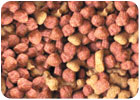
Proper clutch adjustment aids the drilling process.
Back before my dog Lugnut died, I was buying a large bag of Purina at Wal-Mart and was in line to check out. A woman behind me asked if I had a dog - DUH! On impulse, I told her that no, I was starting the Purina Diet again, although I probably shouldn't, because I'd ended up in the hospital last time, but that I'd lost 50 pounds before I awakened in an intensive care ward with tubes coming out of everywhere and IVs in both arms. I told her that it essentially was a perfect diet - that the way it works is to load your pants pockets with Purina nuggets and simply eat one or two every time you feel hungry, and that the food is nutritionally complete, so I was going to try it again. By this time, everybody in the line was listening. Horrified, she asked if I'd been poisoned. I told her no, I'd been sitting in the street, wagging my tail, and a car hit me.

A tasty treat, anyone?
After lack of grease, the problem I see most often is improper adjustment of things like clutches and brakes. The over-center clutches found on many rigs have a “sweet spot” in adjustment where they run and pull best. One or two notches too loose or too tight and they won't pull. This is why you occasionally see a driller with a cheater pipe on the drawworks clutches.
Chances are, the clutch is too tight and the forcing cone can't properly energize the clutch. Not only is this dangerous, it will wear the throw-out bearing very rapidly. I generally adjust my drawworks clutches to the point that they will “click in,” and then tighten them up about two notches. This keeps them from accidentally locking in, but still in the “sweet spot.” This is especially important on rigs that use air to energize over-center clutches. If they click in, the clutch will not disengage at all, and you have to haul-tail to the cab and get the rig out of gear before you hit the crown or pull something in two. Been there, done that!
Rotary and mud pump clutches take a different approach. You want them to click in so that you don't have to hold pressure on the linkage. Continuous pressure on the linkage will eat the throw-out bearings right away, and some of them are darned hard to get at and change. Not only that, they always fail at the worst times. If you are running small-diameter drill pipe, it sometimes is a good idea to back off the rotary clutch a notch or two, so the clutch will slip before you twist off. This usually is not a good idea on mud pump clutches; the cyclic loading of a clutch on a reciprocating pump usually loads clutches pretty well to start with, so any slippage will shorten its life a lot. You do have a working relief valve, don't you?

It's important to use the appropriate product for oil-lubricated parts.
Synthetic oils and grease have vastly improved the life of oil-lubricated parts, such as rotary tables, mud pumps and transfer cases. There are several companies out there making synthetic oil that gets better every year. It costs more than dino oil, but the initial cost is far outweighed by the increased life. I know a guy who runs synthetic oil in his mud pumps and rotaries and hasn't had to rebuild them in 20 years! 'Course, he changes at decent intervals, too.
One place synthetic oil will NOT pay off is in equipment that continuously leaks oil. It is not cost effective running on the ground. Fix the leak, and run the right oil. One note on mud pump gear oil: I see a lot of guys go from 75W90 to 90W140 oil when their pump gets some wear and starts knocking. This won't work! It will actually wear the pump faster. The reason is the thicker oil does not have time to flow into the appropriate places and provide an oil wedge or cushion; the parts will go metal-to-metal and wear twice as fast. I've also found that one of the additives you see at the auto parts stores that makes oil “climb” works well in rotaries and mud pumps; helps get the oil where it needs to be and keep it there.
Gotta go get my tom-cat a bag of food - wonder if anyone actually will ask me if I've got a cat …. ND

Report Abusive Comment